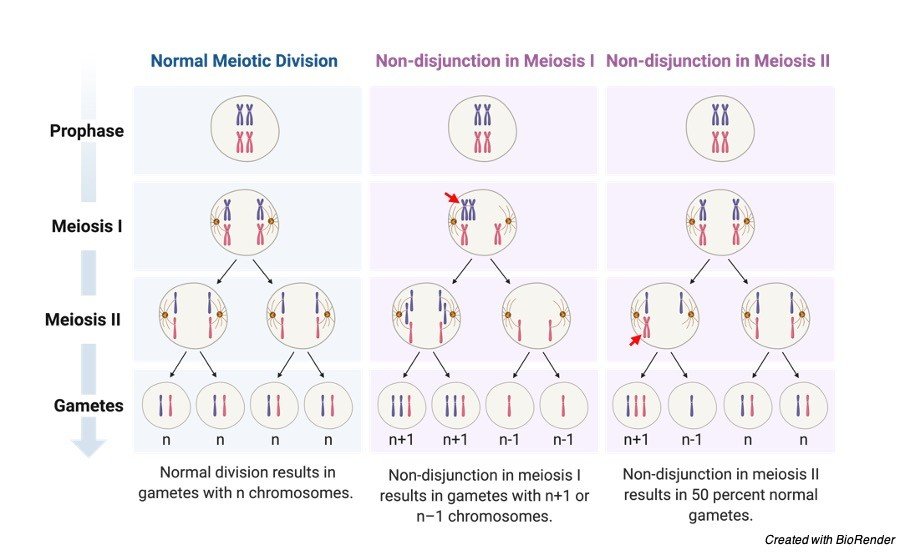What is Down Syndrome?
We know that abnormality in a structure or function of a chromosome leads to various chromosomal abnormalities or disorders. These disorders sometimes make a human an unfit to live a comfortable life with a good healthy lifestyle.
However, these disorders sometimes lead to mortality of an individual even at birth or it also results in lower lifespan of a person.
Down syndrome is also a one such genetic disorder which results in various physical and mental retardation.
This condition is as a result of addition of an extra chromosome in the chromosome number 21 which is also known as trisomy of the chromosome 21.
This is considered as one of the leading genetic disorder in the world.
This condition was first observed by the physician named Langdon Down.
The important physical condition that affects the individual due to this disorder is mental retardation.
The individuals affected to this disease are mostly suspectable to other diseases such as leukaemia and Alzheimer’s disease.
This condition has no treatment or medication and it’s a life long syndrome. But people with this syndrome are practised in speech and language therapies to improve their intellectual activities.
Down syndrome can be diagnosed at the time of pregnancy itself, many such population can be reduced by the decision of the parents.
Causes of Down Syndrome
Down syndrome is due to the addition of one extra chromosome to an 21st chromosome, which is resulted due to the aneuploidy of the chromosome.
This extra chromosome is present in all cells of the body in the chromosome number 21.
This condition occurs 1 in 800 lives. The important risk factor to be consider here is the age of the mother, because the mothers who are above the age of 35 can pass this condition to their children.

Downs syndrome is due to abnormal cell division in the mitotic and meiotic phases, where the chromosome pair are separated and each chromosome are allowed a get another copy of the chromosome. Which results in giving rise to unequal set of chromosomes. This process is generally known as non-disjunction of chromosomes.
Non-disjunction of chromosomes results when the chromosomes are segregated before all of the segregated chromosomes.
The daughter cells contain less chromosome with one extra chromosome, where the kinetochores are attached to the microtubules during metaphase at the opposite poles.
Down syndrome also occurs if translation occurs between two parts of the chromosome. In this case the number of chromosomes is normal but they have an additional part along with them.
But there will be no change or missing of any information but there will be extra segment which results in mental retardation. Of the all-inherited syndromes, Down syndrome does not occur mostly through inheritance. Where as the translocated downs syndrome can be passed from parents to offspring and it is inherited, but here the inherited parent will not show any symptoms for this condition, as the gene is found hidden in them and they are considered as carrier of this disease.
The individuals having this syndrome has a life span of about 60 years approximately.
Types of Down Syndrome
Down syndrome is generally classifying as three types as Trisomy of chromosome 21, Mosaicism, translocation.
I. Trisomy of Chromosome 21
Trisomy of chromosome 21 is the most happening and common type of downs syndrome. Here the extra number of chromosomes is present in the chromosome number 21 which leads to 47 number instead of 46 number of chromosomes.
The main reason for this condition is due to the non-disjunction of chromosomes during meiosis at the time of gamete formation.
Mosaicism
This condition occurs when non-disjunction of chromosomes occur in the mitotic division during the formation of zygote, at the time of fertilization.
This is the rarest type of syndrome occurring in humans. It is considered as mosaicism because some cells have normal 46 number of chromosomes where as the other cells contain extra chromosome which means 47 chromosomes.
Symptoms are not much severe in mosaicism. This condition is very rare among individuals.
Translocation
This condition occurs when the translocation occurs in the long arm of the chromosome. Where the q arm of the chromosome 21 gets translocated to the other chromosome. Where this portion of chromosome get located often to the chromosome 14.
This condition is not due to the mothers age or any other factors it is because of the inherited conditions.
Symptoms of Down Syndrome
People who are suffering with downs syndrome has many abnormalities in both physical and mental condition.
They have very poor immunity, so that they get easily affected with many diseases, such as sleep apnea, gastrointestinal defects, heart defects, thyroid infections.
They are also easily affected with Alzheimer’s and leukaemia.
The people with these conditions can be identified easily through their physical appearance and their activities. After every stage of life, they come across different symptoms.
The infants with this syndrome start growing slowly and they remain short as compared to others of same age.
The main symptoms of this syndrome are stunted growth with short stature, and fold of a flap of skin above the eyes with slanted eyes, protrusion of tongue and flattened nose, mental retardation, cardiac deformities, poor muscle tone but they have good flexibility, and as they have poor language development, they need language therapy and cognitive impairment.
Diagnosis of Down Syndrome
Children with this syndrome are often diagnosed after birth. But due to their different physical structures they are easily identifiable.
If these disorders are identified after birth they cannot be treated or cured. But the activities of the individual can be corrected through undergoing therapies.
It can also be diagnosed before giving birth by amniocentesis, where the amniotic fluid is taken from the mother’s womb with the help of the needle and they are tested by karyotyping as the genetic content of the amniotic fluid the foetus is same.
If the foetus is found to be abnormal, then it is aborted with the parents decision. However, this condition is becoming more common in every region in the world.
Down Syndrome Citations
- Integrated care for Down syndrome. Congenit Anom (Kyoto) . 2016 May;56(3):104-6.
- Down syndrome. Pediatr Clin North Am . 1993 Jun;40(3):523-35.
- Down syndrome, increased risk of dementia and lipid disturbances. Dev Period Med . 2017;21(1):69-73.
- Role of the family physician in the care of children with Down syndrome. Am Fam Physician . 2014 Dec 15;90(12):851-8.
- Down syndrome–genetic and nutritional aspects of accompanying disorders. Rocz Panstw Zakl Hig . 2015;66(3):189-94.
- Down Syndrome. N Engl J Med . 2020 Jun 11;382(24):2344-2352.
- Down syndrome: a review of the literature. Oral Surg Oral Med Oral Pathol Oral Radiol Endod . 1997 Sep;84(3):279-85.
- Endocrine manifestations of Down syndrome. Curr Opin Endocrinol Diabetes Obes . 2018 Feb;25(1):61-66.
Share









